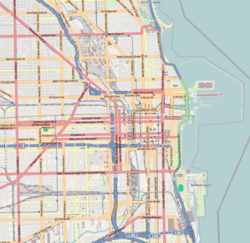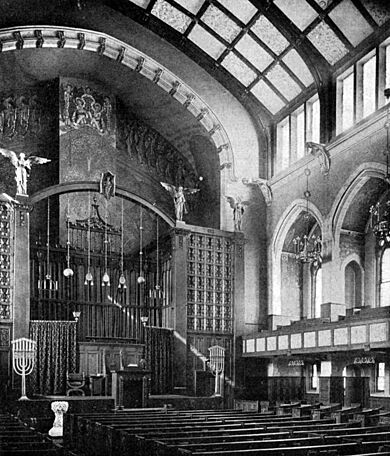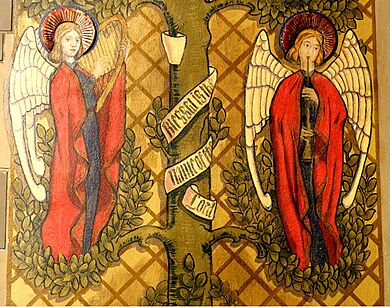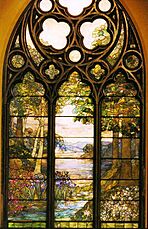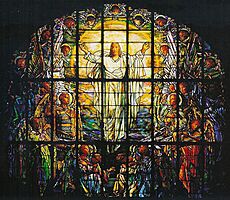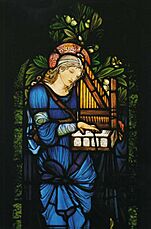Second Presbyterian Church (Chicago) facts for kids
|
Second Presbyterian Church
|
|
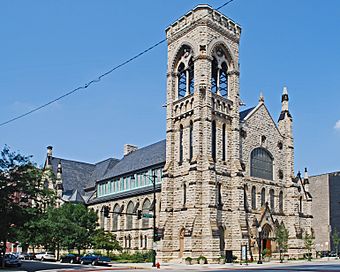
(2010)
|
|
| Location | 1936 South Michigan Avenue Chicago, Illinois |
|---|---|
| Built | 1874 |
| Architect | Renwick & Sands; Shaw, Howard Van Doren |
| Architectural style | Late Gothic Revival |
| NRHP reference No. | 74000754 |
Quick facts for kids Significant dates |
|
| Added to NRHP | December 27, 1974 |
| Designated NHL | February 27, 2013 |
The Second Presbyterian Church is a famous building in Chicago, Illinois, United States. It is located on South Michigan Avenue. This church is known for its beautiful inside, which was completely rebuilt in the Arts and Crafts style. This happened after a big fire in 1900.
The church's main worship area, called the sanctuary, is one of the best examples of an Arts and Crafts church interior in America. It shows the movement's ideas of being simple, handmade, and having a unified design. The church also has nine amazing windows made by Tiffany.
This historic church was added to the National Register of Historic Places in 1974. It was also named a Chicago Landmark on September 28, 1977. In March 2013, it became a National Historic Landmark.
Contents
History of the Church Community
The Second Presbyterian Church started in 1842. It grew from Chicago's very first Presbyterian church, which began in 1833.
From 1851 to 1871, the church community met in a building downtown. This building was known as the "spotted church." It got this name because of tar spots in its stone blocks. A famous architect named James Renwick Jr. designed it. He also designed St. Patrick's Cathedral in New York City. He also designed the first building of the Smithsonian Institution.
By the late 1860s, downtown Chicago was becoming more about businesses than homes. So, the church leaders planned to move closer to where their members lived. Just weeks before the Great Chicago Fire in October 1871, the church moved to the South Side. The Great Chicago Fire then destroyed the old "spotted church."
Many rich Chicago families went to Second Presbyterian Church. These included families like the Pullmans, Cobbs, Blackstones, and Armours. These people moved to Chicago in the mid-1800s to build new lives and help the city grow. They were proud of Chicago and helped create places like the Art Institute of Chicago and the University of Chicago. Robert Todd Lincoln, who was President Lincoln's son, was also a church leader.
In the 1870s, the South Side became a very popular place to live for wealthy people. They built large homes on streets like South Prairie Avenue, South Michigan Avenue, and South Calumet Avenue.
As of 2023, the church has about 125 members from many different backgrounds. It also helps many visitors by offering meals, music, and a sense of community. The church provides after-school tutoring and practice space for the South Loop Symphony Orchestra. It even has a basketball gym.
Original Look of the Church Building
For their new building on South Michigan Avenue, the church again chose James Renwick. Renwick designed the church to look like early English Gothic buildings. It had a steep roof, a round rose window on the east side, and a bell tower in the corner.
The outside of the church is made of limestone with sandstone details. There are not many sculptures on the outside. You can see the Four Evangelists and the head of Jesus on the Michigan Avenue entrance wall. Gargoyles also peek out from the bell tower.
The inside was also very Gothic. It had pointed arches leading to the side aisles. Thin iron columns held up the balcony. The walls were decorated with many stencils. The main worship area in the new building was opened in 1874.
In March 1900, a fire badly damaged the main worship area. The church asked one of its members, Howard Van Doren Shaw, to help rebuild it. Shaw was 31 years old at the time. He had studied architecture at Yale University and the Massachusetts Institute of Technology. Shaw had also traveled a lot in Britain. He knew about the work of Arts and Crafts architects like Philip Webb and C.F.A. Voysey.
The Remodeled Inside: Arts and Crafts Style
Shaw worked with his friend, the painter Frederic Clay Bartlett, and other artists. Together, they created a new church interior based on Arts and Crafts ideas. Shaw changed the original Gothic design. He lowered the roof by 14 feet and moved the support columns closer to the walls. This made the space look wider. He used warm stained oak wood and plaster panels throughout the church.
Shaw designed the main worship area like an auditorium, with no central aisle. It could seat 1200 people. This design was good for a church that focused on preaching and music. The pews are gently curved, so everyone has a good view of the pulpit. The decorations inside are rich but calm. They use colors like brown, buff, dark red, and dull gold.
The church has many angels in glass, wood, and plaster. There are also two brightly colored saints in the lobby windows. This might seem surprising for a Presbyterian church. However, the church members were well-traveled and interested in art. Many had seen grand cathedrals in Europe. They wanted their church to have similar artistic beauty.
Following the Arts and Crafts idea, Shaw and Bartlett designed every part of the new interior to work together. They wanted to create a peaceful and balanced space. They paid attention to every detail, from the carvings on the pews to the light fixtures. Leading Chicago artists and craftspeople helped create elements like the seven-armed electric candelabras. These stand next to the pulpit. Four grand angels stand on top of the organ case.
Many repeating designs connect the different parts of the interior. The most obvious is the angel. About 175 angels are inside the church. This includes the four angels above the organ and those carved into the brackets holding the chandeliers. Another repeating design is the grapevine. You can find it on the pew ends and the screen at the back of the sanctuary. It is also in many of Bartlett's murals and on the screen hiding the organ pipes.
The church installed a Hutchins-Votey organ after the 1900 fire. The Austin Organ Co. updated the organ in 1917. Today, the organ has 43 ranks and 2,600 pipes.
Second Presbyterian Church is important in Chicago's history of society and art. Its beautiful interior is now being seen by more people. Tours about the building's art and architecture are offered regularly. The Friends of Historic Second Church group started in 2006. They help restore the building and organize tours and events.
Church Murals
Bartlett's murals are a highlight of the church. They were widely shown after they were finished. Bartlett came from a wealthy Chicago family. He studied painting in Munich and Paris. For Second Presbyterian, Bartlett found ideas in the work of medieval church painters. He wanted to focus on feelings and spirituality. He found this in the flat, calm figures painted on old Italian church walls.
Bartlett painted directly on the dry plaster walls of the church. The paintings on the ceilings of the arches were done on canvas in his studio. Then they were put up in the church. Bartlett's figures have bold outlines and rich robes of soft blue, red, and green. He used a lot of gold leaf. He also made parts like halos stand out using a plaster technique called pargeting.
The large mural behind the altar is 40 feet wide. It shows the tree of life with a heavenly rainbow above it. Above that is a celestial orchestra in medieval robes. Bartlett made sure his rainbow matched the curve of the ceiling. Bartlett's work in the twelve sections of the balcony shows themes of praise, abundance, and sacred music. Bible verses are painted on the walls below the figures.
Many of these murals were restored in the 2010s and early 2020s.
Church Windows
When the church's main worship area was reopened in 1901, many of its arched openings had simple windows. These windows had small, flowery designs by Shaw. They were made by the Gianini and Hilgart company.
Between 1894 and 1927, special memorial windows were added. Now, only one window on the north side of the church still shows Shaw's original work. Church members gave the other windows to remember loved ones who had passed away.
Nine of the windows are from Louis Comfort Tiffany’s company. They show many new glass-making techniques that Tiffany created. Tiffany wanted to get artistic effects from the glass itself, not by painting on it. He used folded glass, confetti glass, striped glass, and many layers of glass. The windows show different Bible scenes, landscapes, and decorative designs.
At the east end of the church is a brightly colored window showing the Ascension. It was designed by William Fair Kline. Below it are five symbols related to Jesus' suffering, called the Arma Christi. Other windows in the church were designed by Louis J. Millet and McCully & Miles.
-
St. Cecilia window by Edward Burne-Jones, late 19th century
The two Edward Burne-Jones windows in the lobby connect Second Presbyterian directly to the British Arts and Crafts Movement. Burne-Jones worked closely with William Morris, who started the Arts and Crafts Movement in Britain. The Morris and Co. company made these two windows based on Burne-Jones's designs.
The windows show St. Margaret of Antioch in rich red robes. They also show St. Cecilia in blue robes, holding a small organ. These windows were shown in Chicago's Tobey Furniture Co. before a family bought them as memorials. Burne-Jones windows are rare in the United States. These are the only ones known outside of the East Coast.
A big project costing millions of dollars has completed extensive renovation and repair on several windows. More window repair was still happening as of 2023.
See also
 In Spanish: Segunda Iglesia Presbiteriana (Chicago) para niños
In Spanish: Segunda Iglesia Presbiteriana (Chicago) para niños


